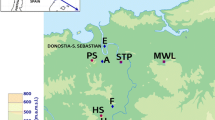Abstract
Municipal wastewater treatment plants (WTP) emit odorous compounds that produce nuisance to the workers and nearby residents. Several chemical compounds contribute to odour problems, among them, sulphurous organic compounds, hydrogen sulphide, phenols and indoles, ammonia, volatile amines and volatile fatty acids. In the current study, hydrogen sulphide (H2S) concentrations were measured during the summer period of 2007 by a portable handheld device at the WTP of Chania City (Greece). Measurements were taken in several places within the facility. The highest hydrogen sulphide levels were measured close to the primary sedimentation tanks and the tanks where the recycled activated sludge is mixed, the sludge from the primary sedimentation tanks reaching 30 ppm. In conjunction with the measurements, the Gaussian dispersion model AERMOD code was modified in order to estimate the maximum odour concentration for very short time steps using peak-to-mean ratios. The probability of detection of H2S exceeds 50% at 400 m distance from the main emission sources (time interval of 5 s) with a relative high degree of annoyance (3.2 AU) under typical summer period conditions. Furthermore, relations between odour annoyance and odour exposure concentrations have been embedded in the model, in order to express the odour impacts in terms of probability of detection and degree of annoyance of the population near the WTP of Chania.









Similar content being viewed by others
References
Abbott, J. (1993). Enclosed wastewater treatment plants—health and safety considerations. Foundation for Water Research Report FR/W 0001. Buckinghamshire: Allen House, The Listons.
Amoore, J. E. (1985). The perception of hydrogen sulfide odor in relation to setting an ambient standard. Berkeley: Olfacto-Labs (prepared for the California Air Resources Board).
Easter, C., Quigley, C., Burrowes, P., Witherspoon, J., & Apgar, D. (2005). Odor and air emissions control using biotechnology for both collection and wastewater treatment systems. Chemical Engineering Journal, 113(2–3), 93–104.
US Environmental Protection Agency. (2004). AERMOD: Description of the model formulation. EPA-454/R-03-004. North Carolina: US Environmental Protection Agency, Research Triangle Park.
Gallego, E., Soriano, C., Roca, F. X., Perales, J. F., Alarcon, M. A., & Guardino, X. (2008). Identification of the origin of odour episodes through social participation, chemical control and numerical modelling. Atmospheric Environment, 42(35), 8150–8160.
Gostelow, P., & Parsons, S. A. (2000). Sewage treatment works odour measurement. Water Science and Technology, 41(6), 33–40.
Gostelow, P., Parsons, S. A., & Cobb, J. (2001). Development of an odorant emission model for sewage treatment works. Water Science and Technology, 44(9), 181–188.
Gostelow, P., Parsons, S. A., & Lovell, M. (2004). Integrated odour modeling for sewage treatment works. Water Science and Technology, 50(4), 169–176.
Henshaw, P., Nicell, J. A., & Sikdar, A. (2006). Parameters for the assessment of odor impacts on communities. Atmospheric Environment, 40(6), 1016–1029.
Leonards, G., Kendall, D., & Barnard, N. (1969). Odor threshold determination of 53 odorant chemicals. Journal of the Air Pollution Control Association, 19(2), 91–95.
McIntyre, A. (2000). Application of dispersion modeling to odour assessment: a practical tool or a complex trap. Water Science and Technology, 41(6), 81–88.
Nagata, Y. (1990). Measurement of odor threshold by triangle odor bag method. Bull Japan Environ Sanit Center, 17, 77–89.
Nicell, J. (2003). Expressions to relate population responses to odor concentration. Atmospheric Environment, 37(35), 4955–4964.
Nicell, J. (2009). Assessment and regulation of odour impacts. Atmospheric Environment, 43(1), 196–206.
Nicell, J., & Henshaw, P. (2007). Odor impact assessments based on dose-response relationships and spatial analyses of population response. Water Practice, 1(2), 1–14.
Piringer, M., Petz, E., Groehn, I., & Schauberger, G. (2007). A sensitivity study of separation distances calculated with the Austrian Odour Dispersion Model (AODM). Atmospheric Environment, 41(8), 1725–1735.
Smith, M. E. (1973). Recommended guide for the prediction of the dispersion of airborne effluents. NY: ASME.
Winegar, E.D. & Schmidt, C.C. (1998). Jerome 631-X portable hydrogen sulfide sensor: laboratory and field evaluation. Report. Chandler: Arizona Instrument Corporation, p. 15.
Yu, Z., Guo, H., Xing, Y., & Lague, C. (2009). Setting acceptable odour criteria using steady-state and annual hourly weather data. Biosystems Engineering, 103(3), 329–337.
Acknowledgments
This work has been supported by the Hellenic General Secretariat for Research and Technology through the program PENED-2003 (project No. 663).
Author information
Authors and Affiliations
Corresponding author
Rights and permissions
About this article
Cite this article
Latos, M., Karageorgos, P., Kalogerakis, N. et al. Dispersion of Odorous Gaseous Compounds Emitted from Wastewater Treatment Plants. Water Air Soil Pollut 215, 667–677 (2011). https://doi.org/10.1007/s11270-010-0508-8
Received:
Accepted:
Published:
Issue Date:
DOI: https://doi.org/10.1007/s11270-010-0508-8




